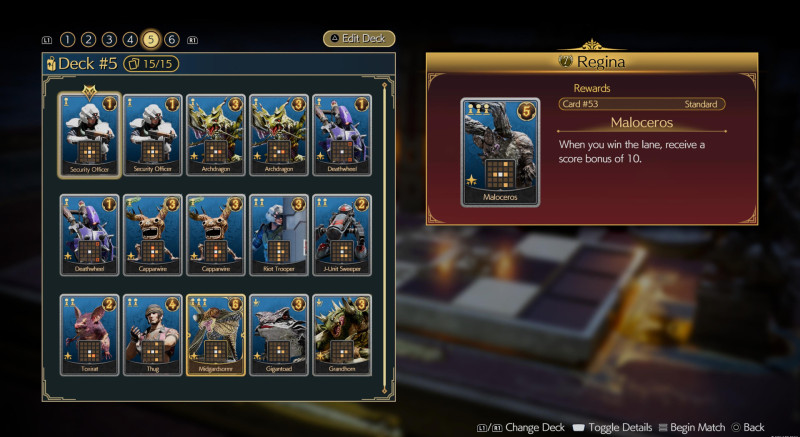Final Fantasy VII Rebirth is finally out, and it’s a treat, especially for fans of the original game – you can read Game Informer’s review here to find out what we loved and didn’t love across our 80 hours with the game. However, regardless of whether you’re a long-time fan or not, one thing new to everyone playing Rebirth is Queen’s Blood.
Introduced early in Rebirth, Queen’s Blood is an in-universe card game that seemingly everyone around Gaia’s various continents plays, from Junon to Nibelheim and elsewhere. And after spending dozens of hours playing it, I can understand why – it rules. It’s easily my favorite game-within-a-game ever, and one I hope spins out into its own thing in some form, be it a digital card game, a physical one, or something else.
It can be a difficult game, though, but it’s one worth learning. It’s both satisfying in its own right but also unfolds across a mysterious side story that plays out through the game’s entire runtime. If you’re struggling to keep up with Gaia’s various opponents, though, we have you covered with the best Queen’s Blood deck, tips and tricks, and more.
Final Fantasy VII Rebirth: Queen’s Blood Tips And Tricks

- Don’t skip the tutorial: Perhaps you think this goes without saying, but someone – and we won’t name who (Kyle Hilliard) – skipped the tutorial and later regretted it. It’s quick, easy, and will open up the door to Rebirth’s best piece of side content.
- Placement is key in the beginning: In the early hours of Rebirth, winning Queen’s Blood is decided by placement and how much of the board you control. However, because you, the player, always go first, your opponent has an advantage: they can see where you place pawns (the green-lit markers that appear on the board depending on where you place cards) and can appropriately counter with a card that turns your pawn into theirs. For that reason, focus less on moving left to right across the board and more on countering your opponent’s moves by taking over their pawn placements.
- Check every general store for booster packs: As you venture to the Grasslands, Junon, Nibelheim, and elsewhere, you’ll come across general stores where you can buy potions, accessories, and more. At the bottom of the store’s inventory, there are often one or two new booster packs to purchase – do so. Even if you don’t use the cards in the pack, each pack costs 500 gil, which is nothing in the grand scheme of things. Better to spend 500 gil on a potential card experiment than miss out on what could be your new favorite card.
- Use local maps to find players: There are 30 matches of Queen’s Blood to complete in the game, and they’re typically doled out to you in groups of two to three matches and a boss. After completing a group of Queen’s Blood matches, you’ll receive another set of challengers to track down. However, and especially as you progress through the game further, you might find yourself struggling to locate these players on the game’s various maps (I did). It wasn’t until my final hours with Queen’s Blood that I realized you really need to utilize the local maps on the map screen to find them. This reveals players in locations like inns and other buildings where they might not appear on region maps.
- Your opponent’s first few moves will tell all: Is your opponent advancing quickly from the right side of the play area to the left? They’re probably trying to lock you out of play space, and this could indicate their deck is built around getting as many cards as possible in play to stack up their numbers quickly. Are they focusing on building up a strong queue of cards on their side of the play area? They might have a deck built around replacement where they replace weaker cards with more powerful ones by placing them on top (and usually, with a special card that gains power after cards are destroyed through this replacement method). Over time, you’ll pick up on these cues that players give off in their opening turns, so keep an eye out for patterns.
- You can quickly restart a match, and it’s better than losing: When you lose a match in Queen’s Blood, you have to sit through the score tally animation and a screen that tells you that you’ve lost the match – it’s humiliating and, across the game’s various matches, adds up to time wasted. However, if you can already tell you’ve lost the match, you can quickly restart the battle by pressing start and hitting the retry battle button.
- Build multiple decks: You get six deck slots in the game, which means you can build six wildly different decks. We recommend doing so, especially in the earlier hours, as you run across many different types of opponents. You could have a replacement deck, a deck around destroying cards, a deck for weakening enemy cards, and one around taking over an entire board, for example. It’s worth doing and gives you an opportunity to experiment with new cards without messing up your favorite deck.
- Just because a card is new doesn’t mean it’s great: I’m not sure if it’s a coincidence on my end or something else, but more often than not, the cards I received upon beating opponents weren’t the greatest. A few hit – and they really hit, gaining a permanent spot in my favorite deck below – but most of them went unused after my initial testing. Maybe it will be different for you. What I’m trying to say is that just because you receive a new card after defeating an enemy doesn’t mean it’s a sure-fire win you should include in your favorite deck. Experiment and see what works and what doesn’t work for you.
The Best Queen’s Blood Deck In Final Fantasy VII Rebirth

After ranking up a few times in Queen’s Blood, which requires defeating a specified amount of opponents and various named “boss” characters, you’ll gain what is, in my opinion, the single best card: Migardsormr. Boasting a base strength of 6, a wide array of mat placement, and a special ability that increases its strength by +1 for every card destroyed after it is played (both enemy and ally cards destroyed, mind you), it’s a card I continuously win on the back of.
Now, you’re, of course, free to build your deck however you want, but my personal deck, the one I consistently win with, is below (ignore the card on the right as it’s just the reward card):

As you can see, the most important card is Migardsormr. From there, you can build it out how you’d like, but when using Migardsormr, it’s important to cater to its special ability. You should be using cards that destroy enemy cards and cards you can place on top of your own, thereby destroying the (ideally) weaker card beneath it.
When using this deck, it’s extra important to get Migardsormr placed as soon as possible. My typical start begins with a Security Clone placed in the middle row to the far left. This turns the two far-left spots above and below it into slots ready for cards that require two placement pawns. I often then place an Archdragon directly to the right of the Security Clone to turn those two-pawn spots into three-pawn spots, which allows me to throw down Migardsormr the next turn.
There are other options to turn around a three-pawn spot quickly, and you’ll want to keep those options open in case your opponent immediately pushes from right to left, but for the most part, this three-turn setup gets Migardsormr out onto the playing field fast. From there, it’s all about playing cards that destroy enemy cards and replacing your own cards with stronger ones, like placing a Grandhorn (with a strength of 3) on top of the Security Clone. That move alone adds 2 to your total count (replacing Security Clone with Grandhorn) and an additional 1 to Migardsormr’s strength since you destroyed the Security Clone.
Regardless of how you build your deck, we highly recommend using Migardsormr to create a deck themed around destroying enemy and ally cards to boost the strength of this serpentine fiend. Do that, and you’ll pick up some powerful wins, like a few of my best wins below:
For more about the game, read Game Informer’s Final Fantasy VII Rebirth review, and then head to Game Informer’s Final Fantasy VII Rebirth hub for exclusive behind-the-scenes features, video interviews, and more.
